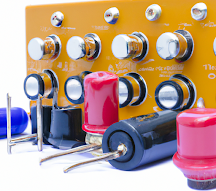What is a "Death Cap" and Why is it Important to Know About it When Working with Amplifiers?
Understanding the Importance of Safety when Working with Amplifiers
Amplifiers
are essential equipment for musicians and audio enthusiasts. They help to
amplify sound, improve tone and add effects to the music. However, before
diving into working with amplifiers, it is essential to understand some safety
precautions. This is because amplifiers are known to have lethal voltage inside
them, and any mistake while working with them can result in a fatal shock.
One critical
aspect of amplifier safety is the "death cap." A death cap is a
capacitor found in older amplifiers that is connected to the amplifier's
grounding switch. In case of a failure, usually short-circuiting, the capacitor
can connect one leg of the AC wall outlet wiring directly to the amplifier's
chassis, resulting in lethal voltage.
Imagine
working on your amplifier with one hand on the strings or guitar bridge and
accidentally touching another piece of equipment that has a grounded chassis.
Your body will complete the circuit through the current coming from the wall
outlet, and you will get an electric shock, which can be fatal.
To avoid
this scenario, it is crucial to learn how to work safely with amplifiers.
Firstly, you need to know how to drain the residual voltage from your
capacitors. This residual voltage can remain inside capacitors even after you
have unplugged the amplifier from the wall socket. You can discharge this
voltage using a resistor or a screwdriver, depending on the amplifier's design.
Secondly,
you need to know how to work safely on the amplifier. This includes using the
right tools, wearing the right protective gear, and working in a well-lit,
ventilated area. You should also avoid working on the amplifier when it's
plugged in or switched on.
Thirdly, you
need to set up a safe work area. This area should be free of clutter, and you
should have ample space to move around. It would help if you also had a
workbench or a sturdy table to work on and a tool kit containing all the
necessary tools.
Lastly, you
need to make some important safety modifications to your amplifier, including
adding a three-prong plug and removing the death cap. Adding a three-prong plug
will ensure that the amplifier is grounded correctly, preventing any potential
shock. Removing the death cap will eliminate the risk of the amplifier's
chassis becoming live in case of a failure.
In
conclusion, working with amplifiers can be dangerous if you don't know how to
work safely with them. The death cap is one of the many potential hazards that
you need to be aware of. Therefore, before working with amplifiers, it's
crucial to learn the necessary safety precautions to avoid accidents and injuries.
By taking the time to learn about amplifier safety, you can protect yourself
and others while enjoying your music or audio equipment.

.png)


HOGWASH!
ReplyDeleteThe "death capacitor" was in fact the "life saving capacitor" since it prevented major shock if you were stupid and deaf enough to leave it switched to the hot side of the power line.
I will paraphrase and augment my Ampeg BT-25 manual from 1966:
Pull the quarter inch cable out of your guitar and dangle the end in the air. Throw the ground switch to the position that produces the least hum. You have now found the neutral side of the power line, known to electricians as the GROUNDED CONDUCTOR (emphasis added). Plug back in and begin playing.
Such caps were VERY durable: Typically 600V film types. They were not failing short anytime soon.
For retrofits, I have discarded the cap and wired the switch to interrupt the ground wire in my new power cord, in case I need to take a line out to the mixing board. If I want to pretend to honor "safety", little miserable pieces of tubing over the terminals where the power cord is soldered to the power supply board redefine the amp as "double insulated". THIS IS WHAT I HAVE FOUND IN MY UNGROUNDED GEAR RATED DOUBLE INSULATED BY UL!
OH BROTHER!
For real safety, make your own power strip with a GFI.